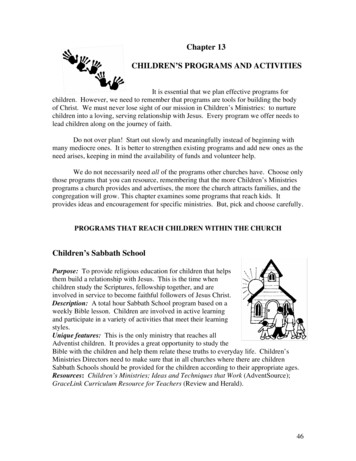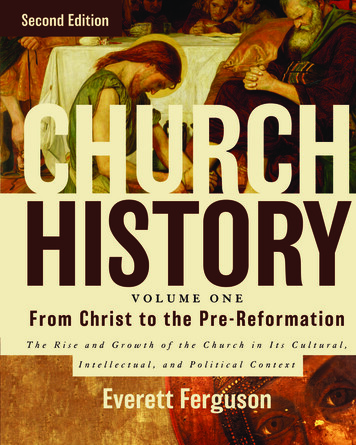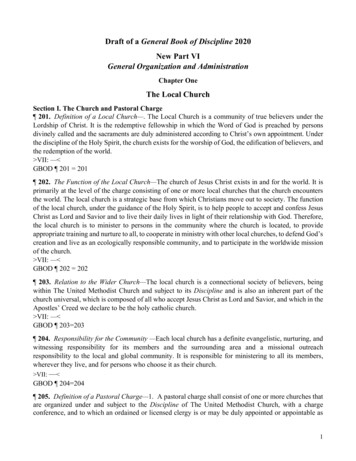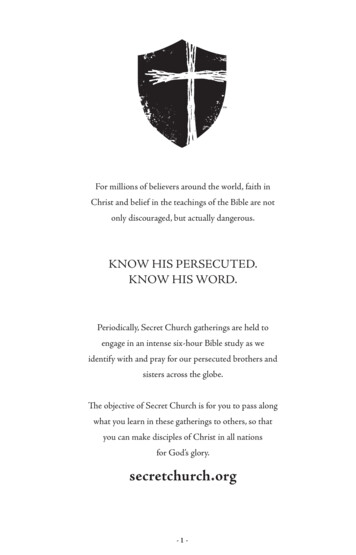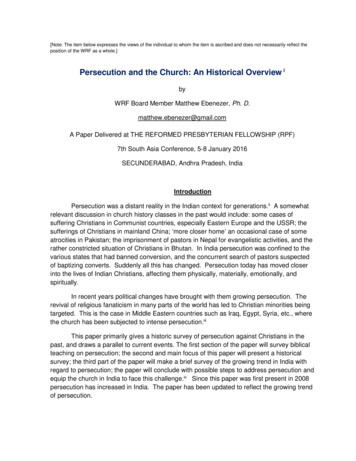
Transcription
[Note: The item below expresses the views of the individual to whom the item is ascribed and does not necessarily reflect theposition of the WRF as a whole.]Persecution and the Church: An Historical Overview ibyWRF Board Member Matthew Ebenezer, Ph. D.matthew.ebenezer@gmail.comA Paper Delivered at THE REFORMED PRESBYTERIAN FELLOWSHIP (RPF)7th South Asia Conference, 5-8 January 2016SECUNDERABAD, Andhra Pradesh, IndiaIntroductionPersecution was a distant reality in the Indian context for generations.ii A somewhatrelevant discussion in church history classes in the past would include: some cases ofsuffering Christians in Communist countries, especially Eastern Europe and the USSR; thesufferings of Christians in mainland China; ‘more closer home’ an occasional case of someatrocities in Pakistan; the imprisonment of pastors in Nepal for evangelistic activities, and therather constricted situation of Christians in Bhutan. In India persecution was confined to thevarious states that had banned conversion, and the concurrent search of pastors suspectedof baptizing converts. Suddenly all this has changed. Persecution today has moved closerinto the lives of Indian Christians, affecting them physically, materially, emotionally, andspiritually.In recent years political changes have brought with them growing persecution. Therevival of religious fanaticism in many parts of the world has led to Christian minorities beingtargeted. This is the case in Middle Eastern countries such as Iraq, Egypt, Syria, etc., wherethe church has been subjected to intense persecution.iiiThis paper primarily gives a historic survey of persecution against Christians in thepast, and draws a parallel to current events. The first section of the paper will survey biblicalteaching on persecution; the second and main focus of this paper will present a historicalsurvey; the third part of the paper will make a brief survey of the growing trend in India withregard to persecution; the paper will conclude with possible steps to address persecution andequip the church in India to face this challenge.iv Since this paper was first present in 2008persecution has increased in India. The paper has been updated to reflect the growing trendof persecution.
2IBiblical teachingThe Teaching of Jesus According to the New Testament the Christian is called tosuffer. Our Lord Jesus Christ Himself warned His followers of the inevitability of persecution(Jn 15:20). v In the Sermon of the Mount he tells the crowds that those who suffer for Hissake will receive a reward (Mt. 5:10). This reference in the Sermon particularizes suffering ofa Christian to the cost of following Jesus. Bearing the name of Christ and living by Christianvalues often attracts opposition due to its conflict with the world. Therefore, Jesus alsoprescribed the reaction to opposition when He told his hearers ‘When someone strikes youon the right cheek give him the other also’ (Mt 5:39). Literal explanations of this text haveresulted in pacifistic conclusions by Christians who refuse to take part in war, but such textsonly highlight the need of self-control and non-violence in the face of extreme provocation.The high ethical and moral demands of Jesus have resulted in would-be disciples turningaway from Him, such as the Rich Young Ruler, and other prospective disciples (Mk 10:22-23;Luke 9:57-62).Central to Jesus’ teaching was His emphasis on the cross. Crucifixion was such adegrading death that it was reserved for non-Roman criminals. Roman citizens, like theapostle Paul, were given the more humane death of beheading. Prior to the cross, JesusHimself during His earthly ministry experienced different types of suffering at the hands of theJews (Jn 10:20; Lk 23:27), and finally at the time of His trial and death, from the Romanauthorities (Lk 23:37). The temptation to flee from suffering was so great in the garden ofGethsemane that He needed great divine empowering to fulfill the work of redemption beforeyielding to the final experience of suffering (Lk 22:43).Apostolic Experience The book of Acts records the growth of the church andconcurrently the growth of persecution (Acts 8). As long as Christians were considered asect of Judaism they were not harassed by the Romans. The Church as a separate entity,however, began to experience stiff opposition from both the Jews and the Romans (Acts 17).Peter and John suffered at the hands of Jewish leaders after the interrogation following thehealing of the lame man (Acts 4). The response of the apostles is joy for being consideredworthy of suffering (Acts 5:41)! Stephen, one of the seven ‘deacons’, of Acts 7, becomes thefirst martyr of the church on account of his testimony. Another martyr was James, thebrother of John (Acts 12:2).viSome experiences of the suffering of the apostle Paul along with his companions inthe ministry, especially Barnabas and Silas, are recorded in the Acts of the Apostles. TheActs, however, does not give a comprehensive account of the sufferings of Paul. This isgiven somewhat comprehensively in 2 Corinthians 11. As for the other apostles, althoughhistorically verifiable details of their suffering, banishment, and martyrdom are not available,tradition indicates that many of them became martyrs for the sake of the gospel. Earlychurch tradition associates Thomas’ place of ministry and martyrdom as India.
3Apostolic Teaching on Persecution The apostles Peter and Paul make references tosuffering in their epistles. Peter tells his readers not to be surprised when they encountersuffering (I Peter 4:12). He exhorts his readers to be steadfast (I Peter 5:10). He warnsthem not to suffer for doing wrong (I Peter 4:15). This admonition of Peter places an onus onChristians to face suffering without retaliating or reacting in a manner that would provide anopportunity for their persecutors to blame them. Paul talks about completing the sufferingsof Christ in Colossians 1:24. Although the text is hermeneutically challenging it reminds theChristian that the suffering is embedded in the Christian faith. Paul’s epistles frequentlymention suffering and teach believers the need to be steadfast in the face of such suffering.For him, suffering, and by extension persecution, was an authorizing mark of his ministry.The Book of Revelation takes us beyond time to view the result of suffering. Herepersecuted saints have ready access to the throne of Christ. Those who were martyrs,whose lives on earth were probably snuffed out in the most horrendous manner, are nowawaiting the inevitable justice and retribution of God (Rev. 6:10). Biblically, persecution isnot an open-ended, aimless experience; it is one which carefully fits into the sovereign planand wisdom of God (Is 55:8-9).Persecution broadly involves several different types of suffering: physical, emotional,or mental. The severity, circumstances, and the results of persecution may vary according toparticular situations. Suffering and persecution have several common elements;nevertheless, whereas suffering in general is not always cause-related, persecution isnormally associated with Christian witness. However, as the reason for suffering is notalways answered in the Bible, similarly, why God allows persecution into the lives ofthousands of innocent men, women, and children, will never be understood. The history ofpersecution gives us insight into what happened throughout the ages in the history of theChurch. These are only recorded persecutions and deaths; there are countless others whomay have perished without any record of what they had suffered.IIHistorical SurveyFirst Century The following account traces persecution of Christians apart from thebiblical period. The Neronian persecution (AD 64), traditionally, was the time when theapostles Peter and Paul died in Rome. The Roman historian Tacitus (60-120) describes thispersecution in some detail. According to him, Emperor Nero, to divert rumors that made himresponsible for the great fire of Rome in AD 64 turned on the Christians “with the utmostrefinement of cruelty.” Tacitus refers to Christianity as a “pernicious superstition” andChristians as “a class hated for their abominations.” Then, as now, there were false chargesagainst Christians such as atheism (because Christians did not use idols in worship),cannibalism (assumptions made from listening to the Eucharistic ritual), and incest (‘brothers’and ‘sisters’ in the Church who love one another). Christians were arrested on their
4confession of being Christian. Tacitus’ description continues “on their evidence,” whichseems to imply that on their information – probably obtained under duress – a vast numberwere arrested. Nero was successful to divert the rumor of arson away from him becauseChristians were hated by people in general. According to Tacitus: “Besides being put todeath they [Christians] were clad in the hides of beasts and torn to death by dogs; otherswere crucified, others set on fire to serve to illuminate the night when daylight failed.”vii Thehistorian, however, concludes by saying, “All this gave rise to a feeling of pity, even towardsmen whose guilt merited the most exemplary punishment; for it was felt that they were beingdestroyed not for the public good but to gratify the cruelty of an individual.”viii Thispersecution, though early, ranks with some of the severest persecutions in the RomanEmpire.Second Century The Neronian persecution of the first century was spontaneous andnot part of Roman policy. Emperor Trajan (reign 98-117)’s persecution appears to be thefirst that was state-sponsored. Pliny the Younger, Governor of the Roman province ofBithynia, was entrusted with dealing with Christians within his jurisdiction. And he wrote tothe emperor to seek his advice. His letter shows a desire for administrative directions toproceed with his punishment of Christians. The mention of “crimes attaching to that name[Christian],” shows that from an imperial perspective the accusations against Christians wereassumed correct. Pliny outlines the modus operandi: he would ask Christians if they wereChristians, and if they answered in the affirmative, he would repeat this question andthreaten them with death. If they persisted in their confession they would be put to death fortheir “pertinacity and inflexible obstinacy.” Pliny then refers to some Christians “whodisplayed like a madness” and were sent to Rome because they were Roman citizens.ixThough Pliny refers to the determined mindset of many Christians who preferredmartyrdom to apostasy, he also refers to Christians who renounced their faith. Many caseswere brought before him, and they grew even greater when an anonymous list containingnames of Christians came to his attention. Those who were accused of being Christiansdenied the claim and were allowed to go free because they worshipped the Emperor andother deities on Pliny’s order and “especially cursed Christ, a thing which, it is said, genuineChristians cannot be induced to do.” Some others claimed that they were once Christiansand now were no longer so. These persons also worshipped the Roman gods and cursedChrist, but they added that their fault as Christians was to meet “on an appointed day,”probably meaning Sunday, early in the morning to sing a hymn to Christ and “to bindthemselves by an oath, not for the commission of any crime but to abstain from theft,robbery, adultery, and breach of faith.” Apparently, the idea of ‘oath’ or sacramentum led tothe suspicion that Christianity was a secret society. This led Pliny to torture twodeaconesses to extract more information about Christians but he did not discover anythingsubversive but only “a depraved and extravagant superstition.”xIn his reply to Pliny, theEmperor Trajan commends the governor and gives certain guidelines on this matter such as,Christians are not to be searched for, rather, if they are accused and proved to be Christiansthey should be punished, but whoever recants his or her faith, by worshipping Roman gods,should be set free. Trajan advises Pliny not to entertain anonymous information in dealing
5with Christians.xi During Trajan’s reign (98-117) Christians were also martyred in Osrhoenein the East.xiiLike Trajan, the reigns of other Roman emperors in the second century such asHadrian (reign 117-138), Antoninus Pius (reign 138-161), and the philosopher-emperorMarcus Aurelius (reign 161-180) were beneficial for the populace but detrimental forChristians. Three outstanding martyrdoms of this century were those of Ignatius of Antioch(bishop c.107-110), the eighty-six year old disciple of apostle John and Bishop of Smyrna,Polycarp, in AD 155, and martyrs of Lyons and Vienne (177). Ignatius was sent to Rome tobe killed, but his letters show a remarkable fearlessness in the face of death. He wrote to theRoman Christians, “Let there come on me fire and cross and conflicts with wild beasts,wrenching of bones, mangling of limbs, crushing of the whole body, grievous torments of thedevil may I but attain to Jesus Christ.” He asked Christians not to intervene on his behalf.xiiiBishop Polycarp was singled out for martyrdom, along with several other Christians,during the festival of Caesar. According to one record, the Bishop welcomed those whocame to arrest him, gave them food, and treated them so well, that they felt guilty for comingto take him to the stadium. He also prayed for about two hours for the worldwide church,while the men watched. Having refused several offers to recant his faith on his way to thearena, he was finally threatened by the Roman official with being thrown to the wild beasts,and then into the fire. Polycarp’s steadfastness amazed his captors, he asked that he shouldnot be nailed to the stake with the words, “Let me be as I am. He that granted me to endurethe fire will grant me also to remain at the pyre unmoved, without being secured with nails.”xivAnother record refers to the persecution at Lyons and Vienne in AD 177. Here Christianswere socially ostracized, not allowed in “public buildings, baths and markets” and often thetarget of mob violence. Eusebius describes the sufferings of some of those who died in thispersecution: Sanctus, Maturus, Attalus and Blandina, a woman of great steadfastness.During this persecution Pothinus, Bishop of Lugdunum, who was over ninety years of agewas kicked and beaten by an infuriated mob.xv In the east there is a questionable record ofone bishop of Adiabene in Persia, Semsoun, who was killed for his evangelistic zeal in 117or 123.xviThird CenturyThe early third century witnessed the brutal death of Perpetua(181-203), from an affluent family, and her slave Felicitas and some other Christians.Perpetua showed considerable courage in the arena and, according to some accounts,guided the executioner’s sword to her throat.xvii By the middle of the third century severaldevelopments led to a period of severe persecution. Zeliang gives the reasons for the rapidspread of Christianity as “the internal and external political problems of the Empire” that wereblamed on Christians; a revival of paganism; the old false accusations against Christians thatwere still remembered; the murder of pro-Christian Emperor Philip by Decius who reversedthe sympathy that Philip had shown to Christians; and the firm refusal of Christians toworship the emperor or the heathen gods.”xviii The Edict of Decius (AD 250) required theoffering of sacrifice to the gods and the worship of the Emperor on a particular day. Theproof was given in the form of a ‘certificate of sacrifice.’ It is recorded that many gave uptheir faith and others bought certificates through corrupt Roman officials or obtained them
6with help from their heathen friends. One such sacrifice dated 26 June 250 was found inFayoum, Egypt in 1893.xix Valerian’s reign began with some toleration for Christians, butsoon the previous policies were re-introduced and intensified. These included demands thatbishops and priests should offer sacrifice and that Christians should not congregate or useRoman cemeteries. Valerian’s persecution (253-260) sheds light to some extent on thecomposition of the Church. Cyprian, the first martyr bishop of Africa, wrote: “Valerian sent aRescript to the Senate ordering that bishops, priests and deacons should forth with bepunished; that senators, men of rank and Roman knights should be degraded and lose theirproperty . . .” and if they continued to confess themselves as Christians, then they were to bebanished, consigned to forced labor, or killed.xx This reveals that the social composition ofthe Christian community included people of wealth and importance who paid dearly forconfessing Christ.Fourth Century The early Fourth Century signaled the climax of a period of greatpersecution lasting about 64 years. The persecution during the reign of Diocletian (303-305)was different to other periods because the emphasis moved from sanctioning physical abuseand killing to an attempt to wipe out Christianity completely. This great persecution wasinfluenced by Diocletian’s devout heathen mother who had “sacred banquets” and distributedmeat sacrificed to idols to those employed in the palace. The Christians refused to partakeof this food, but instead spent time in fasting and prayer. This irked her so much that sheinfluenced her son, Diocletian to take action. He, together with Galerius, apparently spentmuch time getting opinions from both high ranking Roman officers as well as soothsayers.This persecution was timed on an auspicious day that marked the festival of the godTerminus, celebrated on the 23rd of February, and ironically sought the termination ofChristianity. Among the characteristics of this persecution were the burning of churches, thedestruction of Scripture, the stripping of Christians of all “honours and dignities,” their torture,that all cases against them should be entertained, but that “they were debarred from beingplaintiffs in questions of wrong, adultery, or theft” and also they should be denied anyfreedom or voting rights.” A Christian, who in apparent disgust, destroyed the imperial noticewas instantly arrested, tortured, and burnt alive. xxiRecords reveal that Diocletian’s persecution began in Nicomedia where grosscruelty marked the murders of Christians. Determined with zeal to confess their faithChristians refused to bow to severe torture, and countless numbers were beheaded. In themidst of the persecution there was large fire in the palace for which Christians were blamed.This led more deaths by the sword and burning alive. According to Eusebius men andwomen threw themselves into the fire with “an inspired and mystical fervor.” SomeChristians were taken in boats and drowned in the sea and the bones of others who hadbeen buried were exhumed and thrown into the sea for fear that they would be worshippedas gods. There was a practical problem for the state, jails were so full of “bishops,presbyters, and deacons, readers, and exorcists” that there was no room for criminals. Soona new edict promised freedom for those who recanted and torture and death for those whodid not; the Christians chose the latter. xxii Eusebius then goes on to describe, as an eyewitness, the martyrs in Egypt where the confessors were thrown to be torn by wild beasts.While the beasts were irritated with those who provoked them to attack the Christians, the
7Christians were calling the animals to do so. He talks of young and old who were unflinchingin their faith, after the animals had finally attacked the believers the soldiers killed thesurvivors by the sword. He records the deaths of women who were tied naked to trees;others who were fastened to two trees pulled together, and then the trees would be cut freeinstantly ripping the person in two. Every day for years this went on; in Egypt alone Christianmen, women, and children numbering anywhere from 10 to 100 were killed daily. Butdespite this Eusebius wrote, “They [Christians] paid no heed to torture in all its terrifyingforms, but undaunted spoke boldly of their devotion to the God of the universe and with joy,laughter, and gaiety received the final sentence of death: they sang and sent up hymns ofthanksgiving to the God of the universe till their very last breath.”xxiiiDiocletian’s persecution reduced significantly after he abdicated in 305. Galeriuscontinued the persecution, but in AD 311, when he was inflicted by a serious disease andwhile on his deathbed, he issued an edict of toleration. This was soon overturned byMaximin who first pretended to favor Christians, but later joined with anti-Christian parties inthe empire who were trying to force Christians to worship idols. There were severalmartyrdoms during his time. The persecution was not as severe as Diocletian’s becauseMaximin had to contend with war and the advent of various plagues and famines in theempire. He then came out with another edict of toleration.xxiv Soon, however, the worst wasover and Constantine, as a result of divine help that he believed came from Christ, came intopower by defeating his rival and issued the edict of Milan (AD 313) which ensured thefreedom of worship and the restoration of property and rebuilding of churches for Christians.Unfortunately, Licinius who came to power with Constantine continued to persecuteChristians in the eastern regions of the Empire.xxvWhile the conversion of Constantine was the cause of peace for Christians in theWest, it had the opposite effect in Persia. Persia and Rome had been enemies for centuriesand now that Constantine professed Christianity, Persia became anti-Christian. Prior to thisChristians had been persecuted in the East, but these were in the eastern territories of theRoman Empire. For instance, in early fourth century (309) in Edessa a Christian by the nameof Habib, was tortured and burnt for encouraging believers when faced with a decree by theemperor Licinius. However, the Persians, who for centuries had tolerated the Christian faith,turned hostile when Constantine, their political rival, became a Christian. Just prior to hisdeath, Constantine was reportedly planning to fight for the persecuted Christians in Persia.What followed all this was a period of severe persecution for the Church in the East in twoperiods between 340 and 401. Among the trials the Christians had to undergo was doubletaxation by Shah Shapur II which Bishop Simon of Seleucia-Ctesiphon was asked to collect.When he spoke up against the tax Christians were killed. In 344 Bishop Simon was made towitness the mass murder of five bishops and one hundred priests outside the city of Susaand then he too was killed. One estimate of the number of Persian martyrs in this period is190,000.xxviFifth Century Onwards When Rome fell to the barbarians in 410 a new edict, aneastern counterpart of the Edict of Milan was issued by Shah Yazdegerd I proclaimingfreedom for Christians to worship and live in peace, and be able to rebuilt churches that had
8been destroyed. This freedom was not to last long as aggressive evangelism together withattacks on Zoroastrian temples by converts to Christianity revived another period ofpersecution. Although the period did not last long the intensity of torture and the methodsused were grossly inhuman. Following this a short peaceful time was only a prelude to asevere persecution in Mesopotamia in AD 448 when Christians were killed systematically fordays, totaling 10 bishops and 153,000 Christian believers, and this, despite the decision ofthe Persian Church at the Synod of Dadyeshu (424) to move to ecclesiastical independenceand consequently, separation from Persia’s enemies. This second persecution was relatedto the Persian ruler’s declaration of war against Christian Constantinople. The PersianChurch during this period was being persecuted for its Roman Christian associations as wellas for its fast growing religious-fundamentalist type of evangelism.xxvii Among those whosuffered in the continuing persecution was Patriarch Mar Aba (539-552), a formerZoroastrian. A martyr during the reign of Persian emperor Khusro I (531-579) was Dadisho,a former Magi.xxviiiWith declaration of ecclesiastical independence from the West it seems that thePersian Church gradually became caught up with new issues. As the ecumenical councils ofthe church thrashed out issues of belief those who were banished from the empire becauseof their theological viewpoints came to Persia; these included Nestorians and Monophysites.The Nestorians evangelized countries further east. Under Moslem rule, they were givenfreedom to worship under ‘Umar I (634-644) but had some limitations. Under the UmayyadCaliphate (661-750), however, the pressure intensified and restrictions, such as refusal tobuild churches, to display crosses, and to beat wooden sounding boards to call people toworship etc. The most humiliating were the social restrictions that included cutting their hairin a particular distinguishing manner, marking their clothes, riding horses in a particular way,and not being allowed to walk in the middle of the road etc., all of which were to show thatthey were non-Muslims.xxix However, despite three hundred years of repressive Islamic rulethe Christian community survived “though separated battered, limited, and self-wounded.”xxxPersecution continued to haunt the Christian community at different times: in the earlysixth century Monophysite Christians at Najran were massacred by a Jewish Arab king, themassacre resulted in killing of 427 clergy and nuns, 4252 Christians, and 1297 children takenin slavery;xxxi during this time there were women martyrs, some from wealthy backgroundsand others of lowly birth;xxxii in the mid-seventh century the establishment and growth of theNestorian Church in China was wiped out in another two hundred years through a series ofset-backs; in Egypt the church experienced persecution between 1009 and 1016. During thetime of the Crusades (eleventh to thirteenth centuries) relations between Christians andMuslims were quite low, but ironically it also was a time when the preaching friars made upfor the aggression of the Crusades with a Christ-like preaching of the gospel.xxxiii TheCrusades also led to the progressive weakening of Christian influence and growingpersecution in Moslem countries. xxxiv The impact of deteriorating Christian-Moslem relationswas felt even in India where four Franciscan friars, Thomas, James, Peter, and Demetrius,who were actually on their way to China, were killed during a brief stopover at Thana,Mumbai, in 1321.xxxv The most terrible wave of persecution was that of Tamerlane whowiped out Christianity in the late fourteenth century. Thousands died at the hands of
9Tamerlane and though he is considered a Moslem it is recorded that he also killed Muslims,a fact that has led historians to question whether he was a Moslem at all. It is reported thathe invaded North India in 1398 and in the process may have finished off any Christiancommunities that may have been here.xxxvi As Tibetan Buddhism spread in the MongolEmpire it also led to Nestorian churches being replaced by Lamaist places of worship.xxxvii InJapan, there was a period of severe persecution (1612 onwards continuing till the end of thecentury) which was preceded by several martyrdoms in 1597).xxxviiiThe first signs of growing persecution in India appear to come from the earlyeighteenth century in Travancore and Tamil Nadu when administrators of the Rajas, andthen the local Rajas themselves began to harass the Catholics. The Catholics sought thehelp of the Dutch who promptly warned the Raja of dire consequences if he did not stop theharassment. However, even the threat of the Dutch did not have the intended result. In themid-eighteenth century about 8000 Christian nadars who had converted suffered destructionof house and property. Also about this time there is record of Christians imprisoned, andseveral churches destroyed; the Raja in Thiruvananthapuram was informed “about 100Catholic Christian nadars who in the course of a seven months persecution were jailed andtortured.” Some of the persecution was connected with the removal of the kudumi (hair-tuft)worn by converts that the church authorities wanted removed.xxxixThe worst persecution for Christians in India took place during the reign of TippuSultan in the eighteenth century. Earlier Hyder Ali, who at first was friendly with Catholicclergy, began to adopt an anti-Christian stance after 1768 when he suspected Christians ofhelping the British. Catholic clergy suffered harassment and even death, and 9000Christians were forcibly taken to serve in the army or work in the ordnance factory. xl TippuSultan’s dominance of south-western India resulted in more trouble for Christians. Heincreased taxes for Christians - even more than that was already raised by Hyder Ali. TheChristians, on the other hand, helped the British and suffered the wrath of Tippu. From 1784he began to arrest any innocent Christians who were unprotected by their landlords. About30,000 prisoners were chained and put in camps where about one-third died from epidemics.Those who objected to their daughters being taken into Muslim harems were tortured anddegraded in the following fashion: “Their upper lips, noses and ears were cut off and theywere paraded riding on asses and then thrown into dungeons.” Tippu Sultan was defeated bythe British in 1799.xliThe nineteenth century witnessed development that were not favorable toChristianity. In India, Christianity was beginning to be identified with colonial powers. TheSepoy Mutiny of 1857, otherwise known as ‘India’s First War of Independence,’ reveals theclose association of Christianity in India and the British East India Company. M. A. Sherringgives a list of Christians who were killed in this uprising that totals over 30 missionaries and10 Indian Christians.xlii India’s first war of independence, it appears, had religious overtones.18
Early church tradition associates Thomas’ place of ministry and martyrdom as India. 3 . The history of persecution gives us insight into what happened throughout the ages in the history of the Church. These are only recorded persecutions and deaths; there are countless others who may ha

